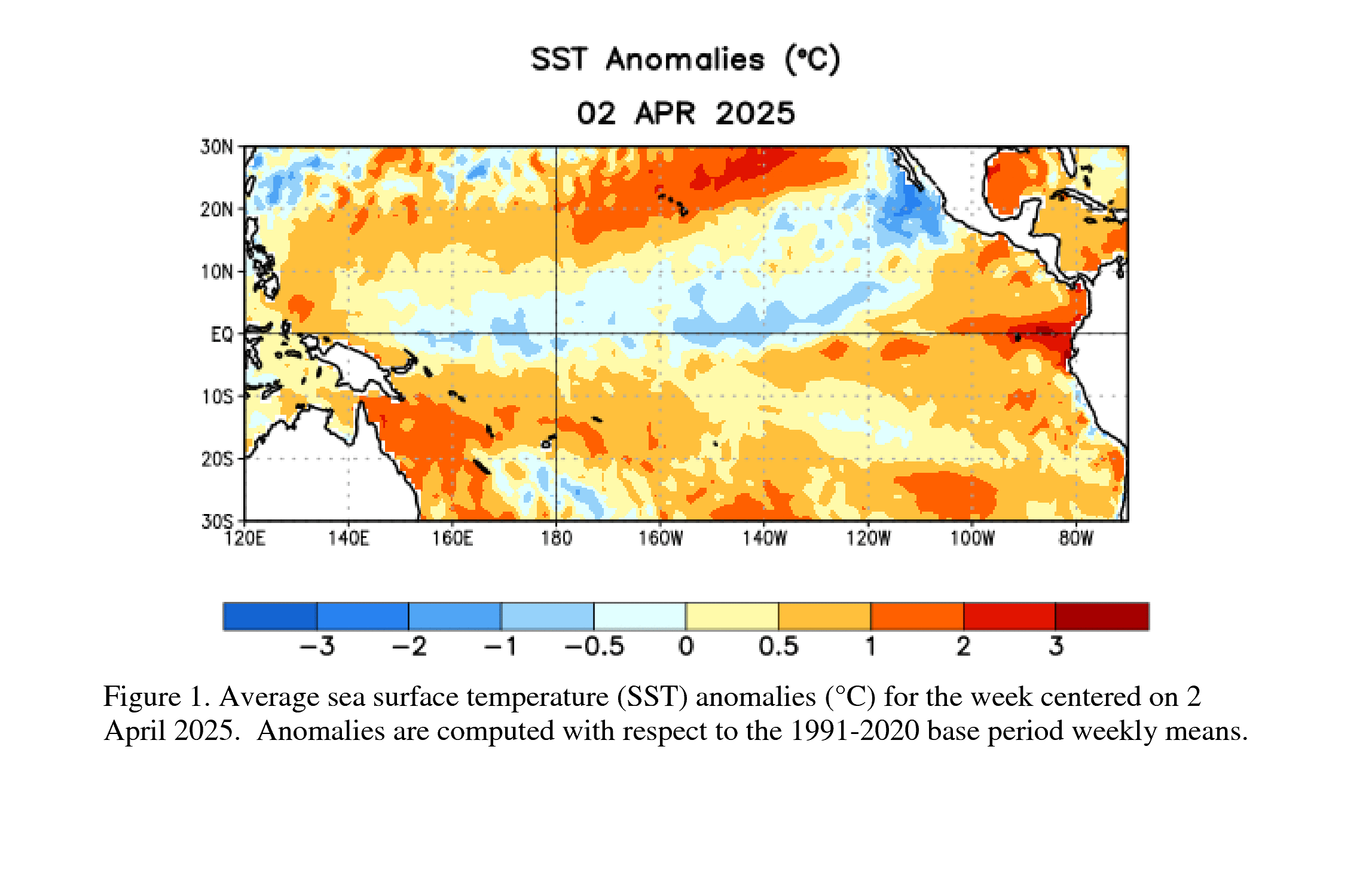
|
July 10, 2025 (updated early-month)
Alert Status:
Not Active
(definitions)
ENSO-neutral is most likely through the late Northern Hemisphere summer 2025 (56% chance
in August-October). Thereafter, chances of La Niña conditions increase into the
fall and winter 2025-26, but remain comparable to ENSO-neutral.
DIAGNOSTIC DISCUSSION:
During June 2025, ENSO-neutral continued, with near-average sea surface
temperatures (SSTs) prevailing across most of the
equatorial
Pacific Ocean. The
latest
weekly Niño index values ranged from 0.0°C to +0.4°C.
Subsurface
temperature anomalies were weakly positive and nearly unchanged from last month,
with mostly above-average temperatures established along the
thermocline.
Over the east-central and eastern equatorial Pacific Ocean, low-level wind
anomalies were easterly and upper-level wind anomalies were westerly.
Convection remained enhanced over Indonesia. Collectively, the coupled
ocean-atmosphere system in the tropical Pacific reflected ENSO-neutral.
Last month, the
IRI
predictions indicate ENSO-neutral is most likely through the Northern Hemisphere winter
2025-26. In contrast, the North American Multi-Model Ensemble favors the onset of La Niña
conditions during the Northern Hemisphere fall, though lasting a shorter duration than NOAA's
requirement of five consecutive overlapping 3-month seasons. While the subsurface equatorial
Pacific remains above average, easterly trade winds are predicted to strengthen in the coming
month, which could portend cooler conditions. In summary, ENSO-neutral is most likely through
the late Northern Hemisphere summer 2025 (56% chance in August-October).
... Read more at the
NOAA's Diagnostic Discussion![]() ,
CPC ENSO Update
,
CPC ENSO Update![]() , and
CPC's Official Probabilistic ENSO Forecast
, and
CPC's Official Probabilistic ENSO Forecast![]() sites,
all updated at the same time in the early-month.
sites,
all updated at the same time in the early-month.
** Note: IRI's Monthly Ouick Look![]() updates twice
per month and presents the latest update between the (I) early-month CPC official Probabilistic
Forecast (shown in this section) and (II) mid-month IRI Model-Based Probabilistic Forecast
(shown in the following two sections).
updates twice
per month and presents the latest update between the (I) early-month CPC official Probabilistic
Forecast (shown in this section) and (II) mid-month IRI Model-Based Probabilistic Forecast
(shown in the following two sections).
(The update of the CPC ENSO diagnostics discussion and forecast is scheduled
for the second Thursday of each month.)

|
July 18, 2025 (updated mid-month)
The neutral conditions are expected to persist through the end of the forecast
period.
As of mid-July 2025, the equatorial Pacific remains in an ENSO-neutral state,
with sea surface temperatures in the Niño 3.4 region close to average.
The IRI ENSO
plume forecast
indicates a high probability (75%) of ENSO-neutral conditions for Jul–Sep 2025.
These neutral conditions are expected to persist through the end of the forecast
period. For later seasons (Oct–Dec and Nov–Jan), the probabilities for
ENSO-neutral decrease slightly to 49% and 49%, respectively, but remain higher
than those for either La Niña or El Niño. Looking ahead to the
2025/2026 period, ENSO-neutral once again becomes the dominant category, with
gradually increasing probabilities.
... Read more at the
IRI Technical ENSO Update![]() ,
IRI Model-Based Probabilistic ENSO Forecast
,
IRI Model-Based Probabilistic ENSO Forecast![]() ,
IRI ENSO Predictions Plume
,
IRI ENSO Predictions Plume![]() , and
IRI Forecast Probability Distribution Based on the IRI ENSO Prediction
Plume
, and
IRI Forecast Probability Distribution Based on the IRI ENSO Prediction
Plume![]() sites, all updated at the same time in the mid-month.
sites, all updated at the same time in the mid-month.
** Note: IRI's Monthly Ouick Look![]() updates twice
per month and presents the latest update between the (I) early-month CPC official Probabilistic
Forecast (shown in this section) and (II) mid-month IRI Model-Based Probabilistic Forecast
(shown in the following two sections).
updates twice
per month and presents the latest update between the (I) early-month CPC official Probabilistic
Forecast (shown in this section) and (II) mid-month IRI Model-Based Probabilistic Forecast
(shown in the following two sections).
(The update of the IRI ENSO forecast is scheduled for the 19th of each month. If the 19th falls on a weekend or holiday, it is released on the closest business day.)
July 18, 2025 (updated mid-month)
|
|
... Read more
here![]() , where
any specific model can be interactively examined, along with other detailed information.
, where
any specific model can be interactively examined, along with other detailed information.
(The update of the IRI ENSO forecast is scheduled for the 19th of each month. If the 19th falls on a weekend or holiday, it is released on the closest business day.)


|
Ocean Niño Index (ONI) - NOAA's primary indicator for monitoring ENSO:
Journal Article: A Relative Sea Surface Temperature Index for Classifying ENSO Events![]()
NOAA CPC's El Niño - Southern Oscillation (ENSO) resources webpage
El Niño Regions:
El Niño and La Niña events tend to develop during the period Apr-Jun and they
The spring predictability barrier: Forecasts made at some times of the year generally have higher skill than forecasts made at other times of the year -- namely, they are better when made between June and December than when they are made between February and May. This is a well-known challenge for forecaster and it can impact statistical models more than dynamical models.
The content posted on this web page solely represents the opinions of the authors and does not constitute a statement of policy, decision, or position on behalf of NOAA or the US Government.
The appearance of external links on this World Wide Web site does not constitute endorsement by the Department of Commerce/National Oceanic and Atmospheric Administration of external Web sites or the information, products or services contained therein. For other than authorized activities, the Department of Commerce/NOAA does not exercise any editorial control over the information you may find at these locations. These links are provided consistent with the stated purpose of this Department of Commerce/NOAA Web site.